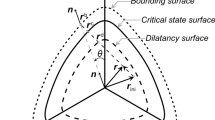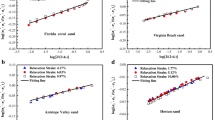Abstract
The paper presents a simple constitutive model for the behavior of sands during monotonic simple shear loading. The model is developed specifically to account for the effects of principal stress rotation on the simple shear response of sands. The main feature of the model is the incorporation of two important effects of principal stress on stress–strain response: anisotropy and non-coaxiality. In particular, an anisotropic failure criterion, cross-anisotropic elasticity, and a plastic flow rule and a stress–dilatancy relationship that incorporate the effects of non-coaxiality are adopted in the model. Simulations of published experimental results from direct simple shear and hollow cylindrical torsional simple shear tests on sands show the satisfactory performance of the model. It is envisioned that the model can be valuable in modeling in situ simple shear response of sands and in interpreting simple shear test results.





Similar content being viewed by others
References
Arthur JRF, Rodriguez JDC, Chua KS, Dunstan T (1980) Principal stress rotation: a missing parameter. J Geotech Eng Div ASCE 106(4):419–433
Arthur JRF, Menzies B (1972) Inherent anisotropy in a sand. Geotechnique 22:115–128
Chaudhary SK, Kuwano J, Hayano Y (2004) Measurement of quasi-elastic stiffness parameters of dense Toyoura sand in hollow cylindrical apparatus and triaxial apparatus with bender elements. Geotech Test J 27(1):1–13
Cole ERL (1967) Soils in the simple shear apparatus. Ph.D. thesis. Cambridge University
Fioravante V (2000) Anisotropy of small strain stiffness of Ticino and Kenya sands from seismic wave propagation measured in triaxial testing. Soils Found 40(4):129–142
Frydman S, Talesnick M (1991) Simple shear of isotropic elasto-plastic soil. Int J Num Anal Meth Geomech 15(4):251–270
Gutierrez M, Ishihara K (2000) Non-coaxiality and energy dissipation in granular materials. Soils Found 40(2):49–59
Gutierrez M, Vardoulakis I (2006) Energy dissipation and post-bifurcation behavior of granular soils. Int J Num Anal Meth Geomech 31(3):435–455
Gutierrez M, Wang J (2008) Non-coaxial version of Rowe’s stress–dilatancy relation. Granural Matter 11:129–137
Gutierrez M, Ishihara K, Towhata I (1993) Flow theory for sand during rotation of principal stress direction. Soils Found 31(4):121–132
Jung Y-H, Chung CK, Finno RJ (2004) Development of nonlinear cross-anisotropic model for the pre-failure deformation of geomaterials. Comp Geotech 31:89–102
Kuwano R, Jardine RJ (2002) On the applicability of cross-anisotropic elasticity to granular materials at very small strains. Geotechnique 52:727–749
Miura K, Miura S, Toki S (1986) Deformation behavior of anisotropic sand under principal axes rotation. Soils Found 26(1):36–52
Moroto N (1987) On deformation of granular material in simple shear. Soils Found 27(1):77–85
Ochiai H (1975) The behaviour of sands in direct shear tests. J Jpn Soc Soil Mech Found Eng 15(4):93–100
Oda M (1975) On the relation τ/σ n = κ tan ψ in the simple shear test. Soils Found 15(4):35–41
Oda M (1981) Anisotropic strength of cohesionless sands. J Geotech Eng ASCE 107(GT9):1219–1231
Oda M, Konishi J (1974) Rotation of principal stresses in granular material during simple shear. Soils Found 14(4):39–53
Osinov VA, Wu W (2006) Simple shear in sand with an anisotropic hypoplastic model. Geomech Geoeng 1(1):43–50
Prevost J, Høeg K (1975) Reanalysis of simple shear soil testing. Can Geotech J 13:418–429
Richart FE, Hall JR, Woods RD (1970) Vibrations of soils and foundations. Int Ser Theor Appl Mech. Prentice-Hall, Englewood Cliffs, NJ
Roscoe KH (1970) The influence of strains in soil mechanics—10th Rankine Lecture. Geotechnique 20(2):129–170
Rowe PW (1962) The stress–dilatancy relation for static equilibrium of an assembly of particles in contact. Proc R Soc Lond Ser A Math Phys Sci 269(1339):500–527
Tatsuoka F (1987) Discussion on the strength and dilatancy of sands. Geotechnique 37(2):219–226
Vardoulakis I, Georgopoulos IG (2005) The “stress–dilatancy” hypothesis revisited: shear-banding related instabilities. Soils Found 45(2):61–76
Yang Y, Yu HS (2006) Numerical simulations of simple shear with non-coaxial soil models. Int J Num Anal Meth Geomech 30(1):1–19
Yoshimine M, Özay R, Sezen A, Ansal A (1999) Undrained plane strain shear tests on saturated sand using a hollow cylinder torsional shear apparatus. Soils Found 39(2):131–136
Zeng X, Ni B (1999) Stress-induced anisotropic G max of sands and its measurement. J Geotech Geoenviron Eng ASCE 125(9):741–749
Author information
Authors and Affiliations
Corresponding author
Appendix: Non-coaxiality angle due to principal stress rotation
Appendix: Non-coaxiality angle due to principal stress rotation
The angle of non-coaxiality angle Δ required to determine the non-coaxiality parameter c in the stress–dilatancy relationships given in Eqs. 9 and 10 is evaluated using the flow rule developed by [10] for plastic flow in the (σ y − σ x )/2 versus σ xy stress rotation plane. This flow rule is shown in Fig. 6. In this figure, the strain increment components (dε y − dε x ) and 2dε xy have been superimposed on the stress plane. Point A is the current stress point. Neglecting the effect of anisotropy, the failure surface is circular and centered at the origin of the (σ y − σ x )/2 versus σ xy axes. The distances \( \overline{\text{OA}} \) and \( \overline{\text{OB}} \) are equal to the current shear stress t and the radius of the circular failure surface, respectively. These distances can be related to the current mean stress s, the mobilized friction angle ϕ and the peak friction angle ϕ p as follows:
Non-coaxial flow rule in the (σ y − σ x )/2 versus σ xy stress rotation plane [10]
On the (σ y − σ x )/2 versus σ xy stress plane, a stress vector makes an angle equal to 2α from the (σ y − σ x )/2 axis (Eq. 7). Similarly, a stress increment vector makes an angle equal to 2ξ from the (σ y − σ x )/2 axis (Eq. 19). On the (dε y − dε x ) versus 2dε xy strain increment plane, a strain increment vector has a length equal to the plastic shear strain increment dγ and makes an angle equal to 2β from the (dε y − dε x ) axis. This plastic strain increment direction is evaluated as the normal to the failure surface at the conjugate point A which is the intersection of the failure surface and the stress increment vector extended from the current stress point. This flow rule is based on the experimental observations that plastic flow on the (σ y − σ x )/2 versus σ xy stress plane is dependent on the stress increment direction [10]. This flow rule should be contrasted with conventional plasticity formulations where the plastic strain increment direction is evaluated at the current stress point independent of the stress increment direction. Details including the experimental verification of the flow rule are given in [10].
From triangle OAB in Fig. 6, the following angles can be obtained:
Using the law of sines:
Substituting Eqs. 32 and 33 in Eq. 37:
Substituting Eqs. 33 and 38 in Eq. 34 gives:
Simplifying the above equation results in the expression for Δ given in Eq. 18.
Rights and permissions
About this article
Cite this article
Gutierrez, M., Wang, J. & Yoshimine, M. Modeling of the simple shear deformation of sand: effects of principal stress rotation. Acta Geotech. 4, 193–201 (2009). https://doi.org/10.1007/s11440-009-0094-3
Received:
Accepted:
Published:
Issue Date:
DOI: https://doi.org/10.1007/s11440-009-0094-3





